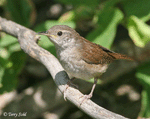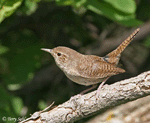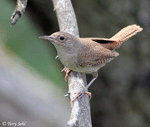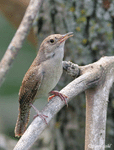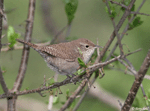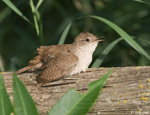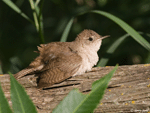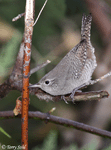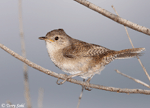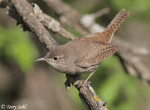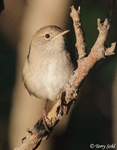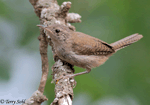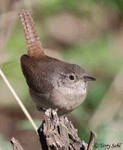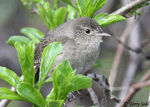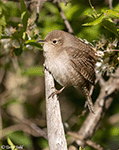House Wren
Troglodytes aedon
| Length: 4 3/4 inches | Wingspan: 6 1/2 inches | Seasonality: Summer |
| ID Keys: Plain wren with faint eyebrow and eye-ring, brown overall, black barring on wings and tail | ||
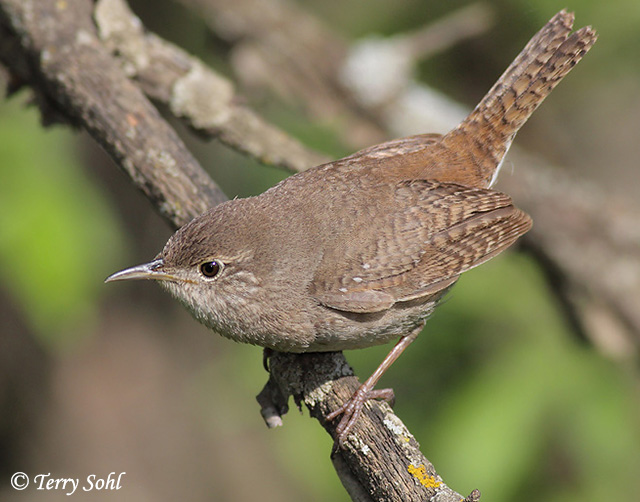 A common hyperactive midget found throughout the
South Dakota, a common sound in the summer time is the song of a House Wren,
often repeated in rapid succession for long periods of time. A
very aggressive courtship and nesting ritual involves the male building numerous
"dummy" nests in any available cavity (nest boxes, trees, buildings,
fences, etc). The female selects one of these, and the male completes that
nest. House Wrens will also aggressively chase other species from
potential nesting sites, even going so far to destroy their eggs and kill their
young. They have adapted very well to a human presence on the landscape, with
nesting and foraging sites often found in suburban yards, parks, and gardens.
A common hyperactive midget found throughout the
South Dakota, a common sound in the summer time is the song of a House Wren,
often repeated in rapid succession for long periods of time. A
very aggressive courtship and nesting ritual involves the male building numerous
"dummy" nests in any available cavity (nest boxes, trees, buildings,
fences, etc). The female selects one of these, and the male completes that
nest. House Wrens will also aggressively chase other species from
potential nesting sites, even going so far to destroy their eggs and kill their
young. They have adapted very well to a human presence on the landscape, with
nesting and foraging sites often found in suburban yards, parks, and gardens.
Habitat:
Prefers semi-open habitats including residential areas, parks, forest clearings and edges, farmstead groves, and brushy thickets. They shy away from dense vegetation without openings.
Diet:
Mostly small crawling insects and spiders. They also are seen eating snail shells, probably for the calcium needed for egg laying.
Behavior:
Very active forager, moving quickly through primarily lower levels of trees and shrubs, but may also forage at upper levels. Will also forage on the ground.
Nesting:
May through August in South Dakota. Historically House Wrens nested in tree cavities, or sometimes rock crevices or other natural cavities near open woodland. Nesting now also often occurs in man-made structures, including nest boxes as well as building crevices or even discarded rubbish (cans, boxes) with holes. The male builds places a multitude of small twigs in several potential nesting cavities, with the female making the final selection for the nesting site. When selected, a cup-shaped depression is built atop the twigs, lined with softer material including fine grasses, hair, moss, or bits of string and debris. The female lays between 4 and 9 eggs and she alone incubates them. The young hatch after 12-15 days, and fledge from the nest about 16 days after hatching. Very aggressive with both other House Wrens and other birds while nesting, they will destroy eggs in nearby nests. Males will even destroy laid eggs of females that have nested with other male House Wrens, mating with the female and beginning their own "family".
Song:
The song of a House Wren is a series of rapid jumbled musical notes, often repeated in rapid succession. They also have a number of other vocalizations with chattering and harsh scolding notes.
- Click here to hear a singing House Wren, recorded in Calaveras County, California1
- Click here to hear a chattering call of a House Wren, recorded near Nogales, Arizona2
- Click here to hear the begging calls of a juvenile House Wren, recorded near Sherburne, Minnesota3
Migration:
Summers through much of the U.S. and southern Canada. Winters in the southern US, along southern Pacific and Atlantic coastlines, and southward throughout much of Mexico.
Interactive eBird Map:
Click here to access an interactive eBird map of House Wren sightings
Similar Species:
- Carolina Wren - Carolina Wrens are larger than House Wrens, Carolina Wrens have warmer coloring, with a warm rusty color on their upperparts and a more pale cinnamon color on their underparts. Carolina Wrens have a very distinct white eyebrow, while that of a House Wren is rather indistinct.
- Marsh Wren - Marsh Wrens are found in wetland habitats that typically do not house House Wrens. They also have a more distinct eyebrow than a House Wren.
- Winter Wren / Pacific Wren - Winter Wrens are smaller than House Wrens, have a short dark bill (compared to longer, two-toned bill of House Wren), and have darker and more distinctly patterned underparts than a House Wren. While House Wrens are often found in and around suburban homes and will sometimes forage or sing in the relative open, Winter and Pacific Wrens tend to stay more hidden in vegetation.
- Sedge Wren - Sedge Wrens are found in marshy meadows that are not as likely to hold House Wrens. They are a warmer, buffier color overall, have distinct striping on their back, and have warm buffy flanks.
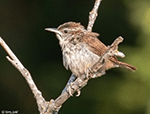 |
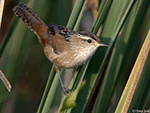 |
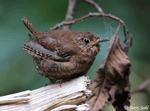 |
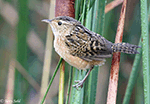 |
| Carolina Wren | Marsh Wren | Pacific Wren | Sedge Wren |
Conservation Status:
Widespread and common with a very wide geographic range in North America, House Wrens appear to have stable or increasing populations over the last 50 years, based on Breeding Bird Survey and other data. The IUCN considers the House Wren to be a species of "least concern".
Birdhouses:
Will nest in manmade nest boxes and houses. Recommended nest box placement and configuration (provided by NestWatch.org) is as follows:
- Place box between 5 and 10 feet from the ground, within 100 feet of woody vegetation.
- Recommended dimensions are 5.5 x 5.5 inches, and 8 inches deep.
- The entrance hole should be 1 inch in diameter.
- House Wrens will destroy the eggs of nearby nesting birds. If you desire other nesting bird species, keep this in mind, and place House Wren boxes far from likely nesting sites of other birds.
Further Information:
- USGS Patuxent Bird Identification InfoCenter, House Wren
- WhatBird - House Wren
- Audubon Guide - House Wren
Photo Information:
May 26th, 2011 - Beaver Creek Nature Area, South Dakota - Terry Sohl
Additional Photos:
Click on the image chips or text links below for additional, higher-resolution House Wren photos.
Audio File Credits:
- 1Ed Pandolfino, XC451690. Accessible at www.xeno-canto.org/451690
- 2Paul Marvin, XC452149. Accessible at www.xeno-canto.org/452149
- 3Greg Irving, XC429241. Accessible at www.xeno-canto.org/429241
| Click on the map below for a higher-resolution view |
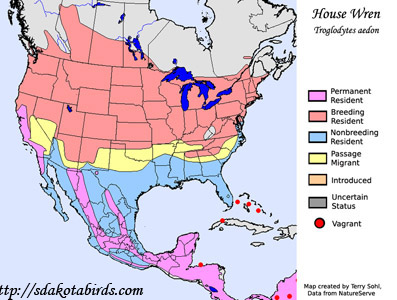 |
| South Dakota Status: Widespread and common |
Additional House Wren Photos
Click for a higher-resolution version of these photos
